Ask the Developer Vol. 14, Nintendo Sound Clock: Alarmo – Chapter 3
10 October 2024
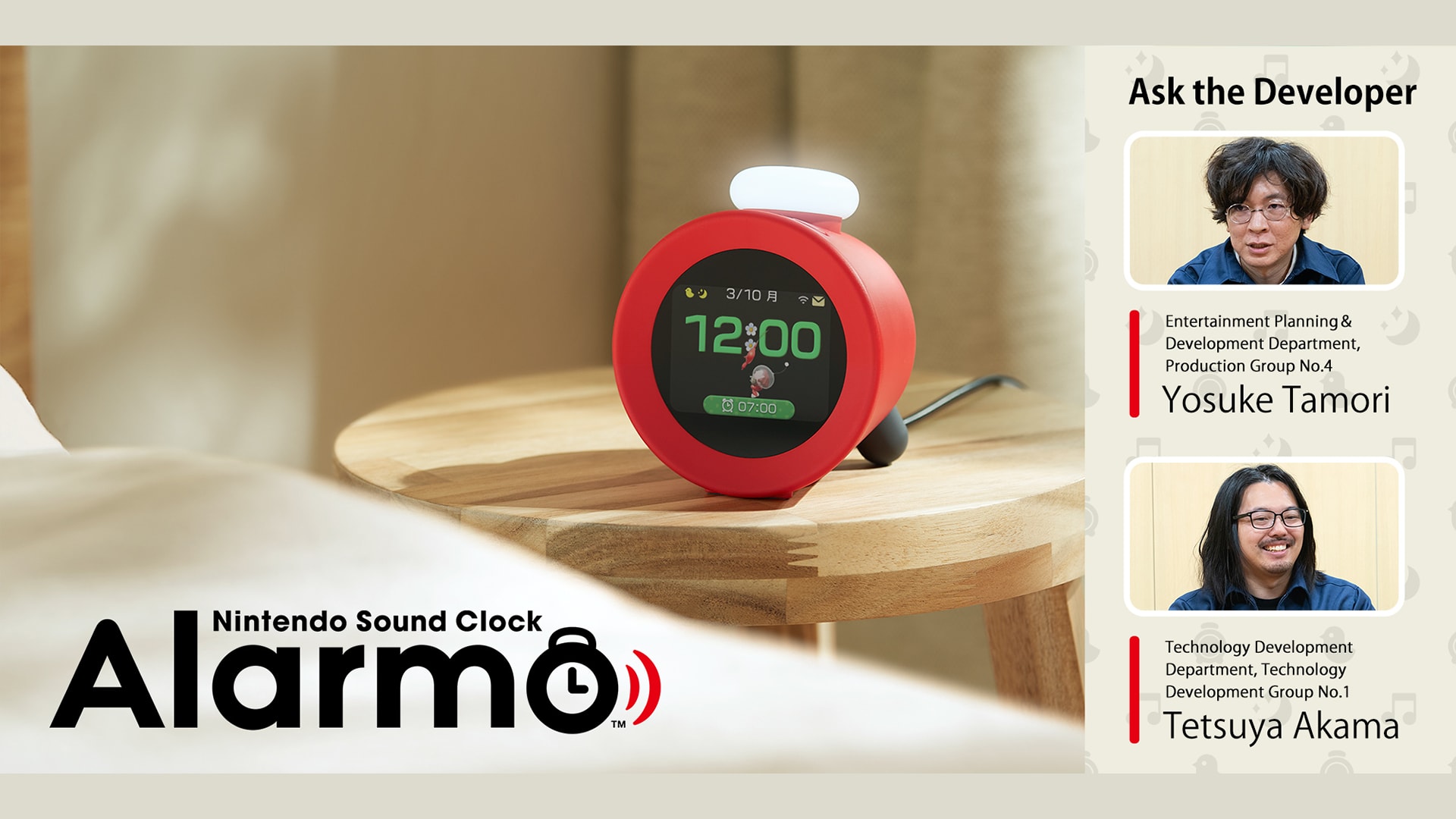
Some of the images and videos shown in text were created during development.
This article has been translated from the original Japanese content.
All images show the Japanese version of the product. Nintendo Sound Clock: Alarmo is available in English.
Chapter 1: An alarm clock that's out of the ordinary, made by Nintendo
Chapter 2: The challenges of cross-functional development
Chapter 3: Not your average alarm clock
Chapter 4: Establishing a new convention for waking up
Chapter 3: Not your average alarm clock
So you arrived at the idea of creating an "alarm clock that's out of the ordinary" after a lot of trial and error, but I imagine you didn't decide on the design and specifications right away. What transformations did it undergo?
Akama:
We've brought along some prototypes today. Here's an early prototype.
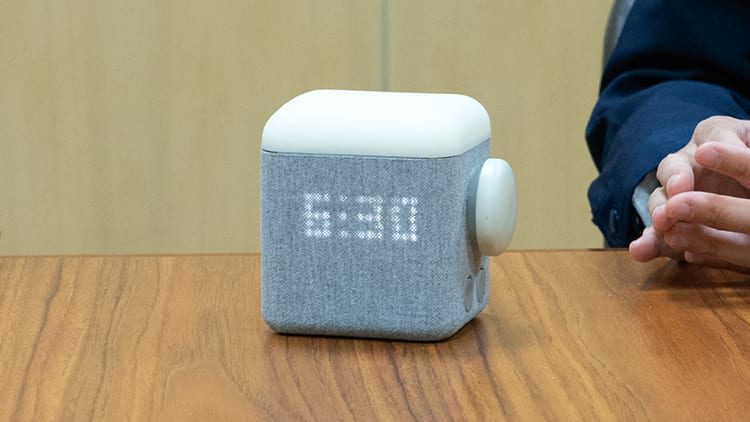
This looks very different from the final product.
Tamori:
Back then, it still didn’t have an LCD screen but instead used a display system called a dot matrix LED, similar to the one used on electronic billboards, with LEDs lined up. However, from a software developer's perspective, we thought it was important for people to be able to use it smoothly without an instruction manual, and we felt that this display system wouldn't be able to communicate the instructions sufficiently. It was especially difficult to explain the product's new features, such as the motion sensor.
Akama:
While we were developing the prototype, we also had the idea-sharing week that we previously mentioned, in which people could make anything they wanted.
One of the ideas that came up in the idea-sharing week. The gameplay involved using your body to play music to the rhythm.
Tamori:
At this point, Akama-san had started saying that he wanted to include a lot of game music, but with this prototype, it was really hard to tell which tracks were set as alarms. For example, the first track from Super Mario was displayed as "M1", and the second track from The Legend of Zelda was shown as "Z2".
Akama:
We also had a "K"... Any guesses what that could be?
"K"? Hmm... No, tell me.
Akama:
Mario Kart. (Laughs)
Ahh, I see... I would never have guessed that.
Tamori:
That's just one example. We knew if we continued like this, we'd definitely run into a brick wall, so we had extensive discussions about the hardware specifications. We discussed things like whether we should have an LCD screen or whether it would be better to put a button on top so it's easier to press. While ensuring we didn't lose sight of the meaning of using the motion sensor, we searched for a balance that would improve usability.
Incidentally, the team members who designed the hardware also designed the user interface. They went through a series of prototypes, trying to find the best balance between design and functionality, aiming to achieve better usability in terms of both hardware and software.
Akama:
The prototype we have here was the result of such trial and error.
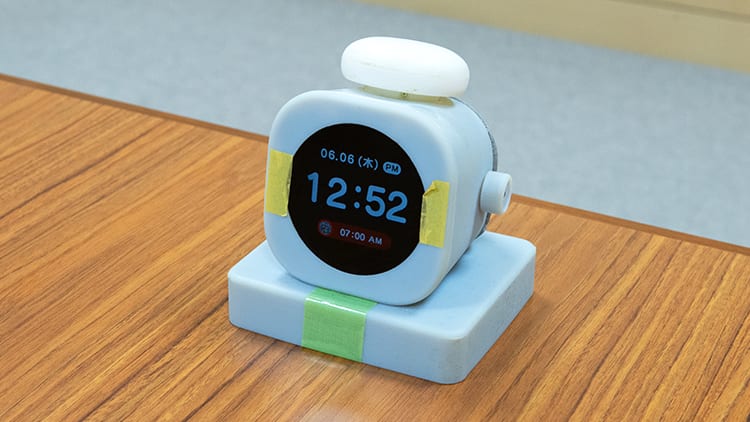
Wow, it's much closer to the final product. It's on some sort of pedestal. What's in the pedestal?
Akama:
Actually, we've disassembled the contents of the first prototype and put them into this part. The system that serves as the brain of the alarm clock is in the base, and the LCD screen and speaker are built into the upper part, with one dial on the top, and a second on the side.
Tamori:
There are fewer buttons compared to the first prototype.
Akama:
Originally, we had a power button and a volume button, but it was a nuisance to keep pressing them. So we integrated the functions of these buttons into a dial on the side. However, even that felt like a hassle to use, so in the final product, we decided to have just one dial and two buttons on the top.
Tamori:
The second prototype was difficult for left-handed people to use because the dial was on the right. Also, we wanted it to be stable even without the base part, so eventually, we placed all the controls on the top.
Akama:
We were also worried that if there were buttons and dials on the side, pressing them could mess with the orientation. To ensure the motion sensor could detect movement correctly, we aimed to design the device so that it would remain in the same position as much as possible when you press the buttons.
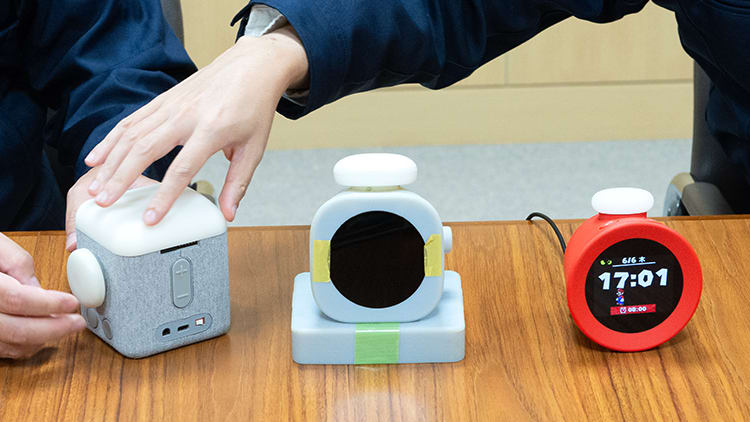
So you designed it considering not only ease of control, but also what happens after it's placed. What was the deciding factor that ultimately led you to this design?
Akama:
The most difficult factor in the design decision was whether to make it look like an alarm clock or not. While it's a highly novel product that offers a completely new experience, we thought it was important to communicate clearly that it's an alarm clock. After a lot of consideration, we decided to go with a design that people would instantly recognise as an alarm clock. Also, Tamori-san requested that if Alarmo was to be drawn as a picture or icon, it should be in a shape that would be instantly recognisable and eye-catching to anyone who saw it, so we ended up with this shape.
Come to think of it, I can't seem to find the motion sensor, which is the vital component of this device. Where is it located?
Akama:
It's actually just above the LCD, but we made it invisible. From the beginning of development, we wanted to ensure that people could use this product without being conscious of the sensor, so we made every effort to make the sensor as unobtrusive as possible.
Tamori:
Since you can't see where the sensor is, we designed the device in the shape of a megaphone so that when you're placing it on a surface, you'll instinctively turn it towards yourself. Also, because the LCD screen was restricted to a rectangular shape, we consulted with the hardware designers to decide on the design and specifications of the screen display so that it would blend seamlessly with the hardware's circular shape.
Akama:
We were very careful to adjust the brightness of the screen so that it hopefully wouldn't disturb the user's sleep. The motion sensor brightens the screen as you move your body to look at it, and some developers said this function would be useful even for a regular clock.
In terms of design, the colour is quite unusual for an alarm clock, which makes it eye-catching. What was the reason you decided to go with just red in the end?
Tamori:
There were originally several body colours under consideration, and the final candidates were white, red and grey. Although we designed it so that it would be recognisable as an alarm clock, we didn't want it to look like an ordinary alarm clock. We decided to be bold and make it red, so it's clear at a glance that it's an "alarm clock that's out of the ordinary" and that it offers a unique experience. Red is an eye-catching colour that we hope will add to the excitement people feel when they set the clock up in their bedrooms.
It's also slightly different from conventional alarm clocks in that it needs to be plugged in. Why did you decide to have it connected to a power source rather than making it battery-powered or rechargeable?
Akama:
One of the primary reasons is that this device uses a motion sensor to constantly check whether a person is in bed, so if it was battery-powered, it would only last about two weeks at the most. An alarm clock that requires frequent recharging and battery replacement would be useless. And it would be a disaster if you woke up in the morning to find that the batteries had run out. (Laughs)
Another factor was that we wanted to create an alarm clock that could be used without being touched again once it was placed. When you first start using it, you may have to fiddle around with the settings a bit, but over time, you'll need to do this less and less. After that, you'll be able to use it just by leaving it plugged in. Rather than having to change batteries, even if it's only once a year, and take care of the clock, we wanted an alarm clock that would require no maintenance at all, so we decided to have it plugged in.
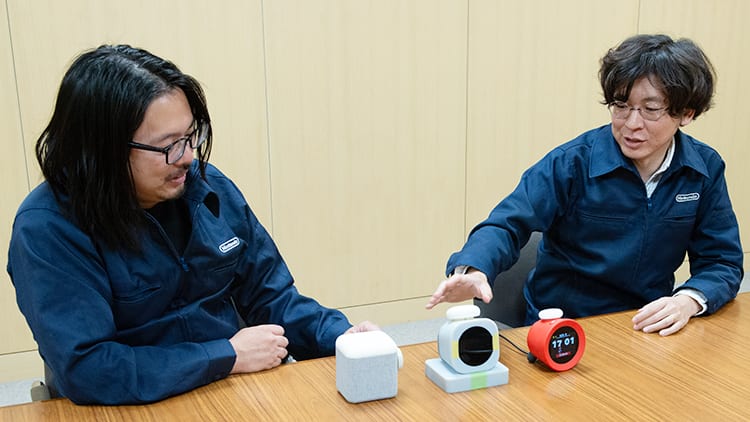
I see. So there were various thoughts behind even this kind of feature. By the way, I understand that the motion sensor isn't something completely new, but that it's already being used around the world for other purposes as a radio wave sensor. In this project, you've used the motion sensor as a way to operate an alarm clock, creating a new experience that makes waking up more fun. The process of using something that already exists in different ways and with a unique perspective to create something new seems to be in line with former Nintendo developer Mr Gunpei Yokoi's philosophy of "lateral thinking of withered technology" (5).
(5) A development concept advocated by Mr Gunpei Yokoi, former General Manager of Nintendo's Research & Development 1 Department, who led the development of various electronic toys, Game & Watch, and Game Boy. This was a theory that new hit products could be created by taking widely-used technology that isn't cutting edge anymore, and using it for new and different purposes. This belief impacted Nintendo's product development in the years that followed.
Tamori:
When we were developing this product, radio wave sensors were still a rapidly evolving technology, so we weren't particularly conscious of that thought. However, in hindsight, using it as a motion sensor may have some connection to that idea.
Akama:
In terms of hardware, the know-how of creating easy-to-use buttons that we gained through game console development was applied to the dial of Alarmo, and I think this might be, in a sense, lateral thinking. There aren't many dials in the world that light up, rotate, and can be pressed. After much searching for a dial knob that met our requirements, the team decided to design one from scratch.
Development wasn't easy, but the hardware and software engineers, drawing on their experience in game console development, kept on working and created many prototypes to ensure that rotating and pressing the dial felt pleasant and to pursue the optimal light intensity. Through repeated trial and error, we believe that we've created something entirely new – from the dial alone, you can see this is not your average alarm clock.
Tamori:
Our team members who'd been working on game development environments and related tools made a special tool for creating alarm sounds. Thanks to this tool, we've been able to create lots of alarm sounds efficiently. We were able to apply the know-how we'd cultivated through game development to something completely different – an alarm clock.
So, Alarmo's features and mechanisms, as well as its novelty as an alarm clock, were created by bringing together the knowledge and experience of different team members.
Tamori:
Speaking of novelty, Alarmo is equipped with speakers that are very large for a Nintendo product.
Akama:
We also went through a lot of trial and error with the speaker. Even though we're using a large speaker, we designed the device to be as compact as possible so that it could be placed anywhere. We even deliberately made the speaker face backward to provide the sense, however small, of being surrounded by sound. With the help of the hardware and software engineers involved in the sound design, we incorporated all sorts of ideas. As a result, I think we were able to create something new for Nintendo hardware.